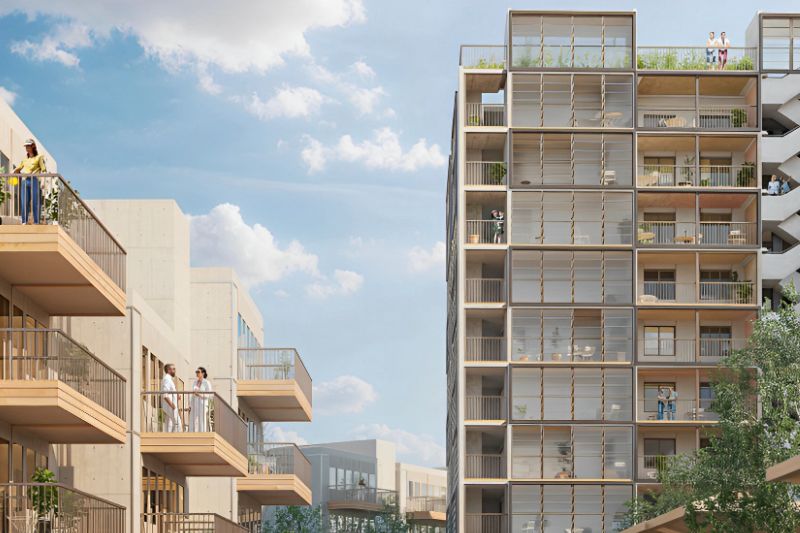Sign up to the Built Offsite Newsletter

Sustainable solutions for Kharkiv’s modular reconstruction.
Kharkiv, Ukraine’s second-largest city, has endured significant destruction from ongoing conflict, with an estimated 70% of its buildings damaged or destroyed. As part of the effort to rebuild and revitalise the city, the Rebuilding Kharkiv competition sought innovative modular solutions that could address housing and public space needs. The competition, a central element of the broader Kharkiv Masterplan project, was developed by a collaboration of international organisations, including the Kharkiv City Council, UNECE, the Norman Foster Foundation, and Arup. (main pic: Andrew James Jackson’s “Healing Kharkiv: From Rubble to Renewal” proposal. Image courtesy of Andrew James Jackson/Cundall/Gensler/Norman Foster Foundation).
Competition focus
The competition’s key objective was to develop modular systems to retrofit existing concrete housing blocks and create vibrant, sustainable public spaces. Proposals had to consider community engagement, energy efficiency, and adaptable modular designs, incorporating local materials wherever possible. Special attention was given to the inclusion of bomb shelters and other protective infrastructure. The competition’s guiding principles were based on modularity, scalability, and environmental sustainability, all crucial to ensuring a long-term recovery and revitalisation of Kharkiv’s urban landscape.
Winning Proposal: A Modular Approach to Healing

The winning proposal, titled “Healing Kharkiv: From Rubble to Renewal”, came from Andrew James Jackson, a partner at UK engineering firm Cundall, in collaboration with architecture firm Gensler. Their modular system used prefabricated exoskeletons that could be attached to damaged Soviet-era housing blocks, offering structural reinforcement while improving thermal insulation. The innovative use of locally produced materials, including reinforced concrete with recycled aggregate from war debris, demonstrated the practicality and sustainability of the design.
Jackson’s proposal stood out for its combination of modularity and adaptability. The prefabricated exoskeletons could be produced offsite and then attached to existing structures, significantly speeding up the rebuilding process. This approach also considered community well-being, with plans to create communal outdoor spaces under modular timber canopies, serving as venues for markets and social gatherings while also harvesting rainwater. This emphasis on both structural and social renewal resonated with the competition’s goals.
Second and third place proposals
The second-place proposal, *Blooming Towards The Sun*, by Zigeng Wang, focused on redeveloping areas based on the extent of damage. It introduced irrigation systems for sunflower cultivation—a symbol of Ukraine—tying the project to national identity and agricultural self-reliance. The third-place team from Yıldız Technical University in Turkey offered a novel approach to community safety with a modular system of underground concrete shelters. These could serve as protection during wartime but also function as cinemas or public spaces during peacetime, demonstrating the adaptability that the competition encouraged.
Why modularity was essential
The competition’s emphasis on modularity proved essential in selecting the winning proposals. Kharkiv’s housing is predominantly made up of large, uniform blocks, which makes modular systems particularly suitable for retrofitting and upgrading the damaged structures. The winning designs demonstrated how prefabrication could play a role in swiftly producing components offsite, bringing efficiency to the rebuilding process while minimising disruption in the city.
Moreover, modular construction offers flexibility in scaling solutions to different neighbourhoods across the city. The adaptability of the winning designs ensured they could be deployed in various contexts, from densely populated areas to smaller communities, giving the city’s reconstruction effort both versatility and consistency.
The next phase for the winning proposals will involve detailed development, with potential collaborations with local communities and suppliers.
Find full list of winners HERE